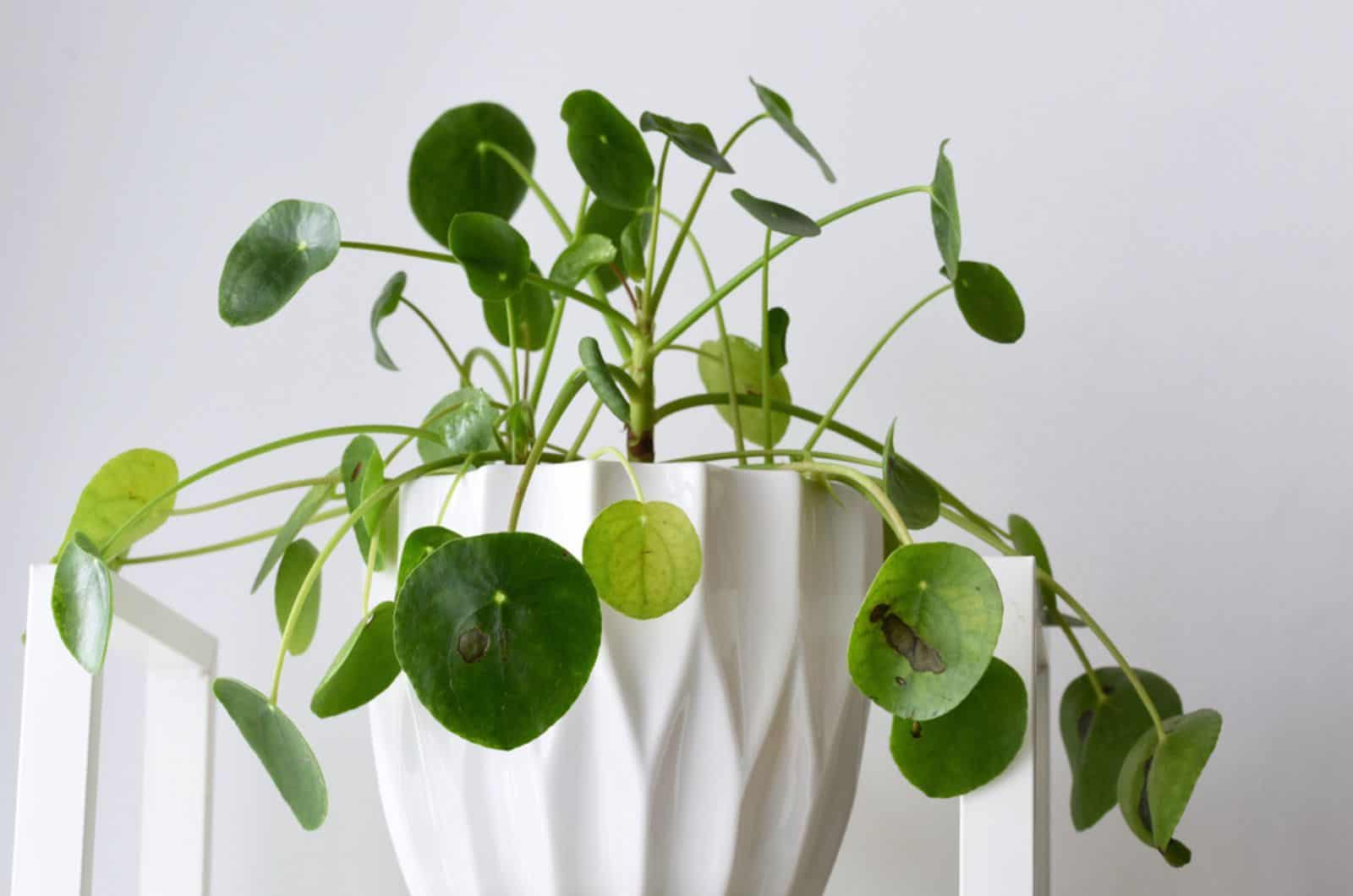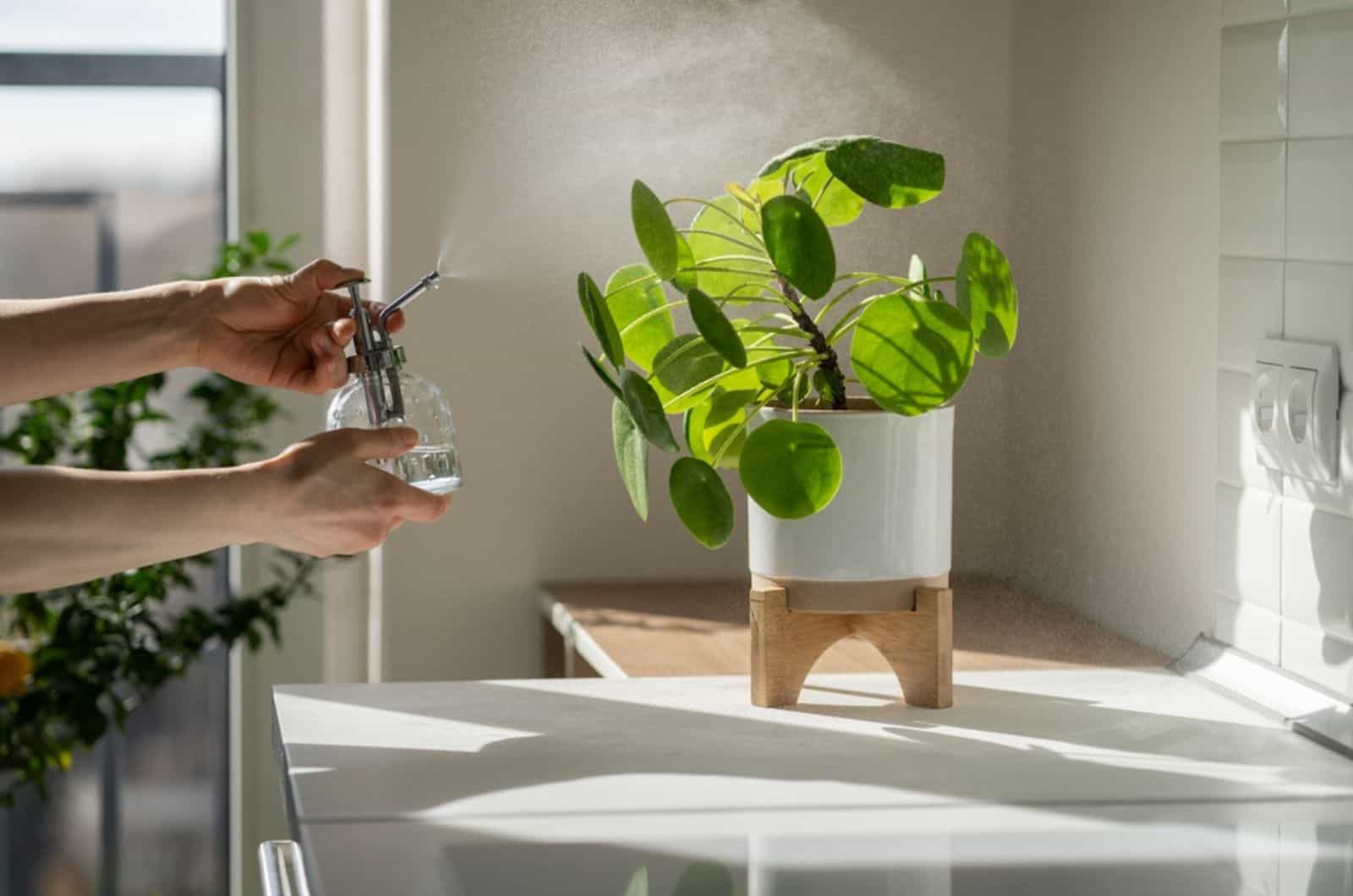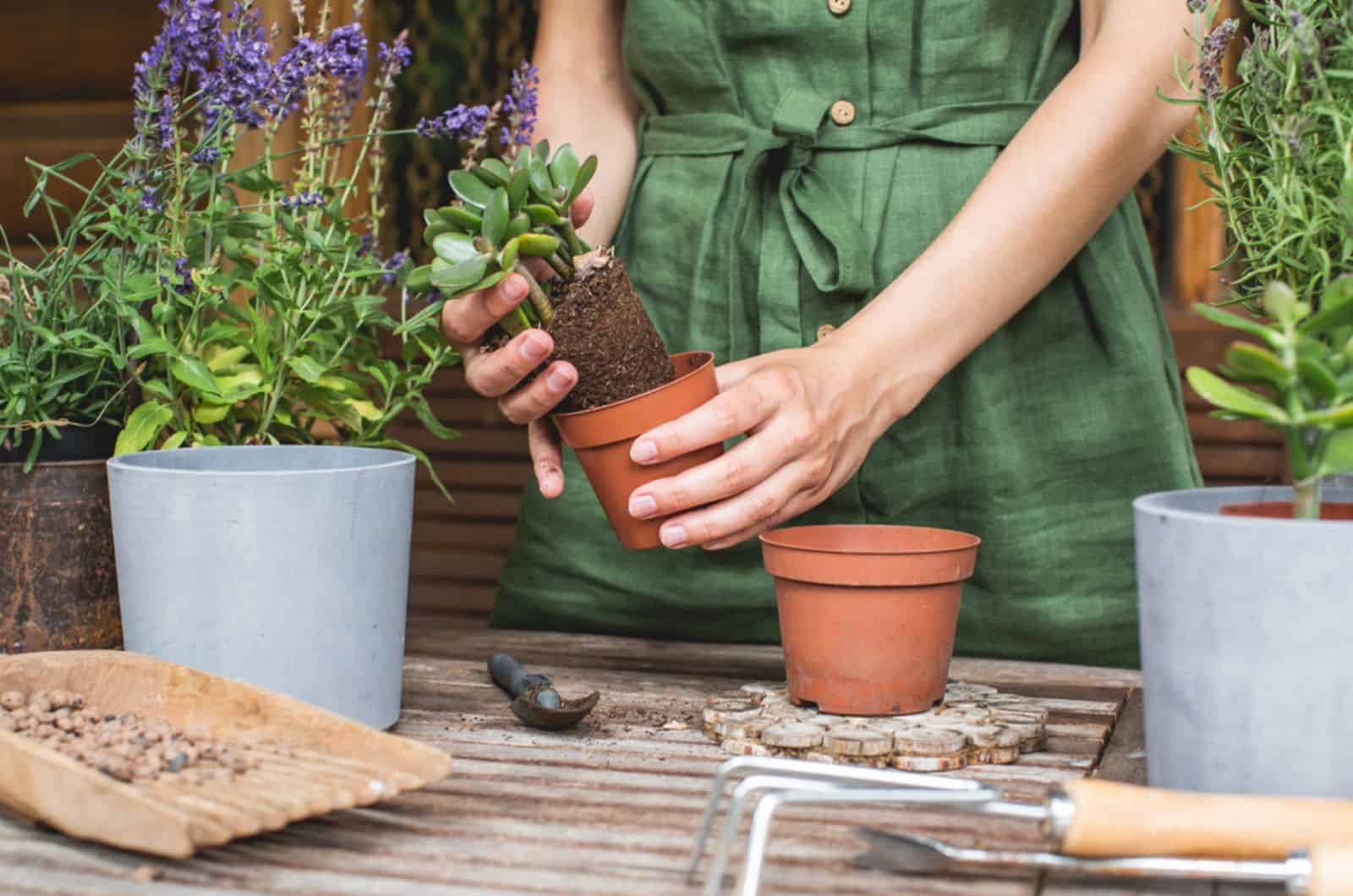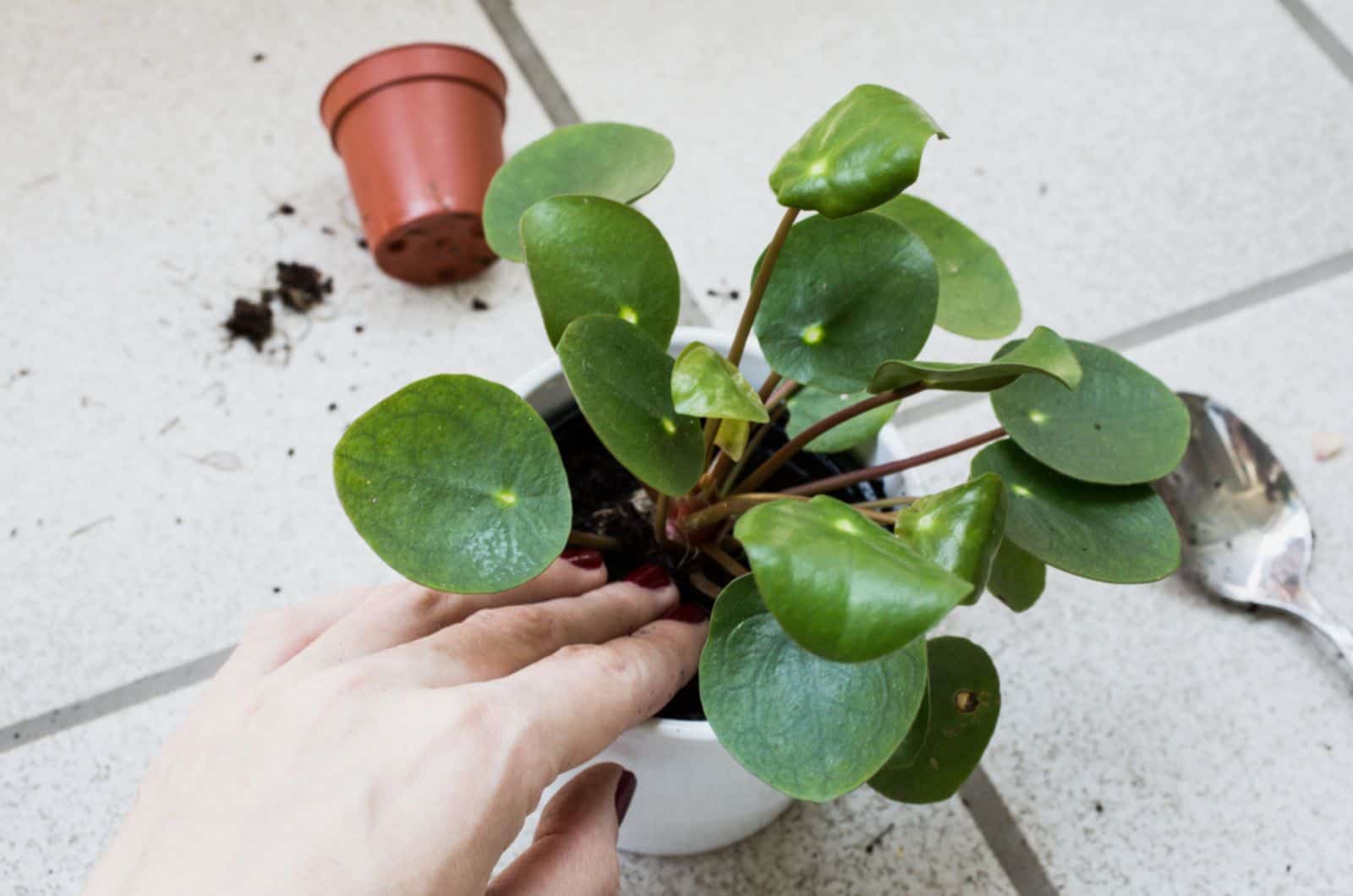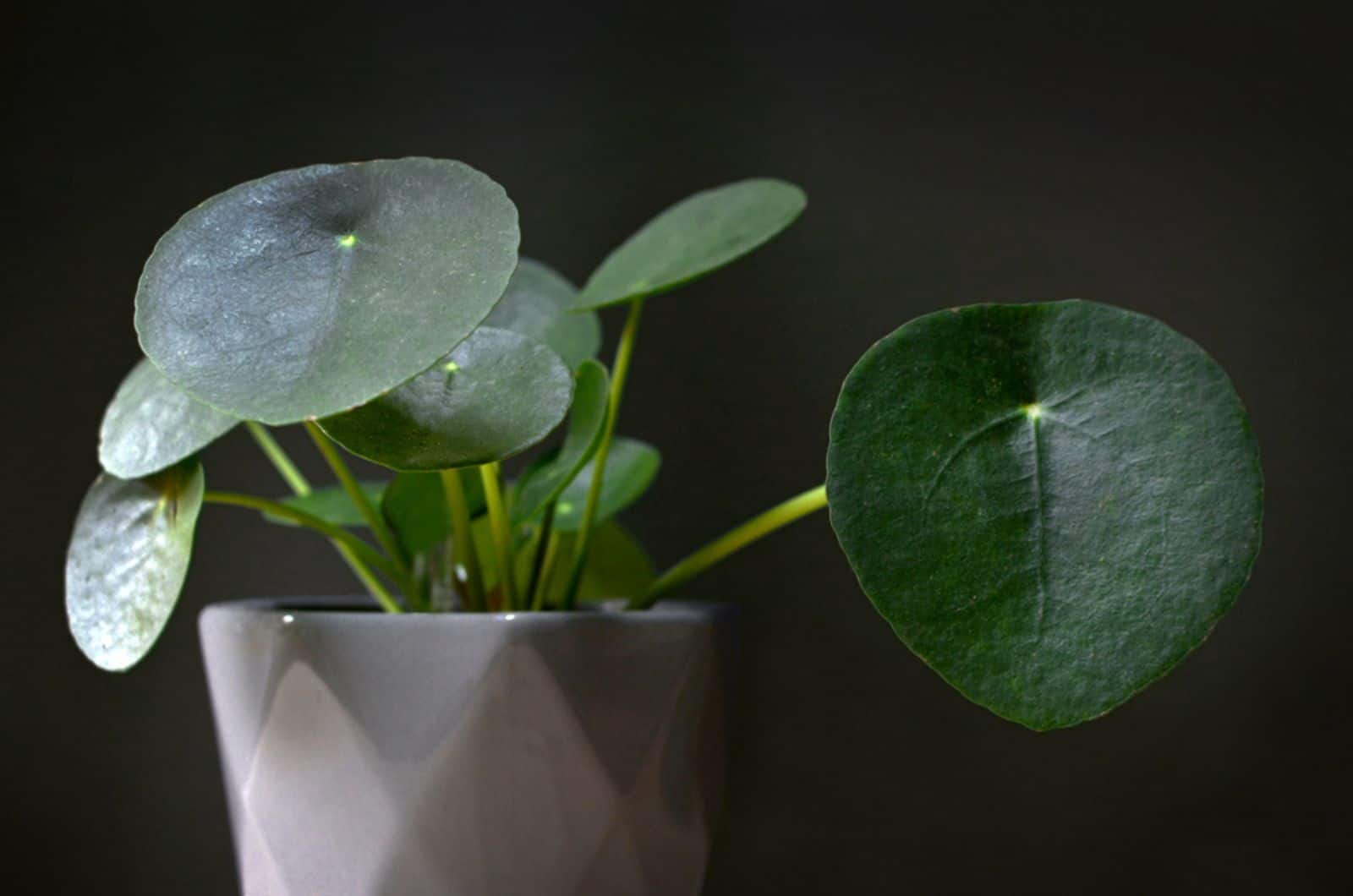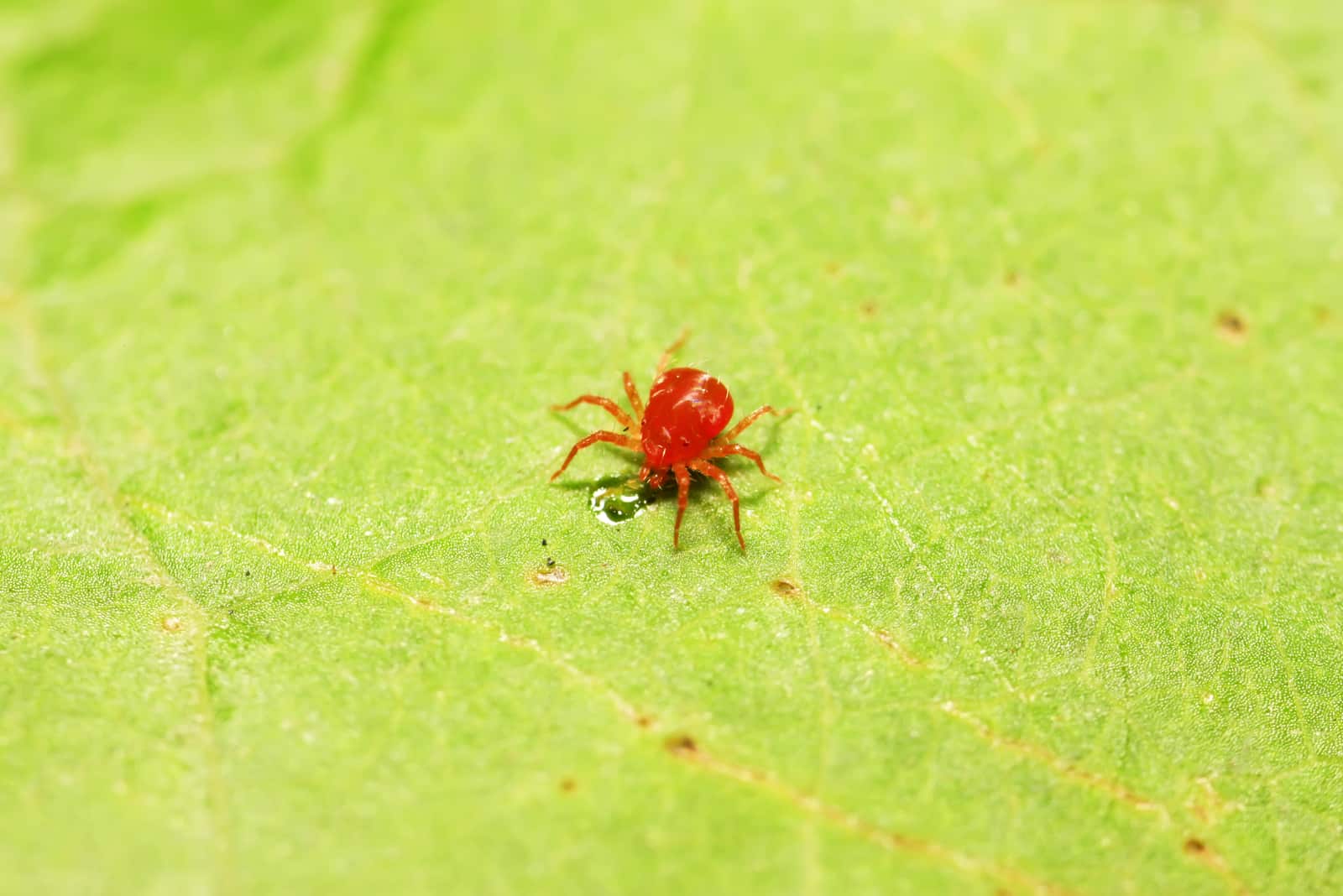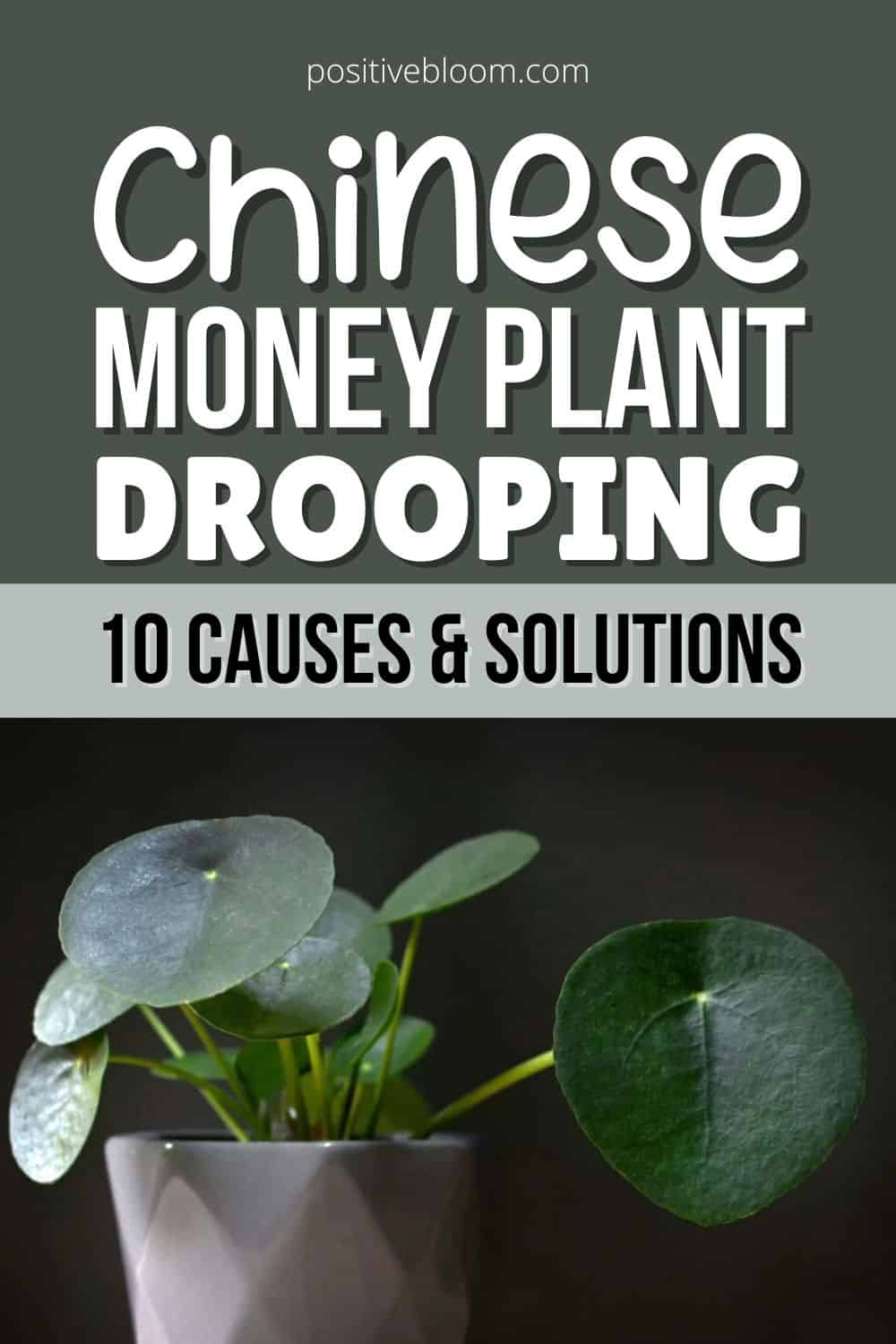If you notice your pancake or Chinese money plant drooping, it doesn’t always mean that some terrible disease is causing it! It can simply be a sign that its light source is coming from the side and not from the top.
So, if your plant looks healthy and its leaves are green and strong, you don’t have to change your plant care routine. Although, you could move it to a new location where the light it gets mostly comes from above and not the side.
However, sometimes drooping leaves are a sign of something more sinister, and in that case, you should determine what is wrong with your plant.
Read on to learn the ten most common causes of a droopy money plant, as well as some ways to deal with them.
Let’s first look into some main specifics about this plant:
[table id=310 /]
Reasons And Solutions For A Chinese Money Plant Drooping
The Chinese money plant is one of the most common pilea varieties and is relatively easy to care for.
But what if something goes wrong and your plant starts drooping?
Today we’ll discuss the most common causes of a wilting Chinese money plant and provide a couple of tips and tricks you can implement to save your plant.
However, prevention is the best cure, and if you follow this plant’s care guide, you won’t have to deal with this unsightly (and possibly dangerous) issue.
Of course, you can always turn to propagation. Just find some healthy stems so that you don’t spread diseases or pests, and also to ensure it can survive the process.
1. Overwatering
Too much water is one of the most common reasons for drooping indoor plants, including this pilea variety. Overwatering your plant once or twice shouldn’t be a problem, but if your plant is left to sit in the wet soil for a long period of time, it will develop root rot.
Root rot is a fungal disease that may kill your plant if left untreated, and although drooping is a common sign that your plant is suffering from this disease, it isn’t the only one.
You will also notice your plant’s leaves turning yellow, and if you ignore this symptom, the disease will progress, and your plant will start drooping.
Other symptoms that may follow are stunted growth, browning of the leaves, and darkening of new growth (new leaves may even die if the disease is not caught in time).
Furthermore, if you notice a rotting smell coming from the pot, your plant is in big trouble.
Sadly, giving your plant too much water is not the only thing that can lead to overwatering. Heavy soils and containers without drainage holes may also lead to water clogging.
Solution To Overwatering
What can you do to save your plant?
Well, if you’ve only overwatered your plant a couple of times, you should really stop irrigating for a while until it has absorbed all the water from the container.
You should also replant your pilea into a new pot if the current one doesn’t have holes in the bottom and switch to a well-draining soil based on perlite, coco coir, or sphagnum peat moss.
If you do detect some signs of root rot, you should check the soil, and if it’s dripping wet, you should definitely take your pilea plant out of the pot and inspect its roots. If you notice soft, soggy, and mushy roots that have turned darker (black or brown), you should remove them before the disease spreads to the healthy roots.
After cutting and discarding the diseased roots, you can treat the remainder with some fungicide to help kill any fungi you may have missed.
If the infection hasn’t advanced, you might even get away without removing the roots and just treating the diseased areas with fungicide.
After removing the rotten roots and/or treating them with a fungicide, repot your plant into a new container filled with a fresh, well-draining medium. Water the soil lightly, and keep it that way for some time.
Finally, place your plant in a high-humidity environment to provide it with the best chance of survival.
2. Underwatering
Not giving your plant enough water is not as terrible as overwatering it, but it can still lead to problems, and you may even notice the curling of the pilea leaves.
Underwatering can lead to many other issues, such as foliage falling off, yellowing or browning of the leaves, and stunted growth.
But how do you recognize whether your plant is overwatered or underwatered?
Well, the first thing you should do is check the soil. If it’s dry and not soggy, your plant needs more water.
However, if you have just irrigated your plant and are unsure which of the two causes is making your plant droop and change color, you might want to check the leaves.
If the yellow or brown spots are crispy and light, your plant is underwatered. Leaves of overwatered plants are soft and limp, and you can easily feel the difference.
Solution To Underwatering
The solution for this issue is pretty straightforward; water your plants! However, just irrigating your plant once won’t suffice, and its root system, stems, and leaves won’t be happy with the amount of water they’ve received.
Instead, water your plant whenever you feel the top few inches of the soil are dry. You can use a moisture meter, but sticking your finger into the mix and checking how much soil sticks to it will give you the same results.
Don’t forget to allow the excess water to drain because you don’t want your underwatered plant to end up overwatered.
Sadly, discolored leaves cannot regain their green shade, so you will have to prune them to create more space for new growth.
3. Overfertilization
Another frequent issue is giving plants more nutrients than they need. Overfertilization and fertilizer burn can make plants more susceptible to pest infestations and diseases.
Droopiness is not the only symptom of too many nutrients. Stunted growth, leaf discoloration, burnt or dried leaf edges, total collapse, and death can also occur (in extreme cases).
The salt build-up may make it hard for the plant to absorb water, which is why we see various symptoms connected with inadequate watering.
However, this problem is not irreversible, and there are a couple of things you can do to give your plants a new lease of life.
Solution To Overfertilization
The first thing you need to know is that plants should only be fertilized during their growing season because that’s when they actively grow and can use the additional nutrients.
If you feed your plants during dormancy, you risk salt build-up and overfertilization.
Furthermore, you should always water your plants before feeding them to make the nutrients available to the plant.
Salts can build up in the soil if you don’t change it frequently, so you should replace the growing medium approximately once a year.
However, if you don’t want to change the soil, you can flush it with water.
Put your houseplant into a tub (or take it outside to reduce the mess), and slowly pour water into the soil, allowing it to drain through the holes.
Use four times more water than the pot’s volume, and let the water leave through the drainage holes and the soil dry a bit before moving it to its new spot.
4. Nutrient Deficiency
Plant care for the Chinese money plant is relatively simple, but it does require a bit of attention. If you never feed it or repot it into new soil, it might lack the minerals necessary for healthy growth.
However, not fertilizing your plant is not the only reason why they may lack certain nutrients. Highly acidic or alkaline potting soils may make the nutrients in it unavailable to your plant.
Also, there are plants that prefer a certain pH level in their growing medium, and if you stray too much from it, the nutrients won’t be accessible to your green friend.
Furthermore, too much or too little water in the soil can also make it difficult for your plant to absorb minerals, so you should make sure that your plant gets a proper amount of water before adding more fertilizer.
Lack of nutrients is also manifested as brown or yellow leaves, or even chlorosis and stunted growth.
However, plants might suffer from a deficiency of a specific nutrient, so it is essential to identify which mineral the plant lacks before starting any sort of treatment.
Ensure you double-check your findings before doing anything about this issue.
Solution To Nutrient Deficiency
Once you’re sure which mineral your plant needs, you can get a fertilizer high in that particular nutrient.
For instance, if your plant lacks nitrogen, you should use ammonium sulfate or some other nitrogen-rich fertilizer. And the same goes for every other deficiency.
However, you cannot use these fertilizers as your plant’s primary food source. They may lead to overfertilization, and your plant will get too much nitrogen and little to no potassium, phosphorus, magnesium, etc.
Therefore, once you’ve got your plant back to full health, you can start using houseplant fertilizers, which these plants love.
Simply dilute them to half-strength, and feed your plant once a month from spring to fall.
5. Transplant Shock
There are many perks of repotting plants, such as fresh soil, a new batch of nutrients, and more space for the roots to grow.
However, moving plants from one container to the other and simply changing their substrate will result in transplant shock.
Your plant’s leaves will turn yellow and brown between the veins, and these discolorations will only keep getting darker and drier. Curly and droopy leaves are also common symptoms of transplant shock, which may prove fatal if your plant fails to adjust to the new soil.
You should try and avoid the possibility of transplant shock at all costs, and this doesn’t mean not repotting your plants! You can learn more about it in the section below.
Finally, you will need some tools for houseplants, such as potting mixes, new pots, miniature shovels, rakes, etc., so consider getting some on Amazon if you don’t already own a set.
Solution To Transplant Shock
One of the first things you need to be careful about when repotting plants is the state of their roots. If they are mushy and soggy (i.e., if there is some root rot), you should be prepared for transplant shock.
In this case, you should remove the diseased roots, plant your green buddy into fresh soil and a new pot, water it thoroughly, and hope for the best.
However, there are some tips that can help you reduce the effects of transplant shock on all your plants (including veggies).
The first thing you need to do is make sure that your plant is well hydrated before moving it to a different pot. The relocation will disturb the plant and mess with its water uptake, but it shouldn’t be much of an issue if you’ve moisturized your plant properly before repotting.
You should also irrigate your money plant immediately after transplanting. (Don’t worry, it’s not a succulent, so it doesn’t get overwatered that easily!)
Transplanting on an overcast day or keeping your plants in indirect sunlight can help alleviate the stress your plant will undergo, as water won’t evaporate so quickly.
You can also consider repotting or transplanting your plants or seedlings early in the morning or in the evening when temperatures are lower.
Finally, you shouldn’t disturb your plant’s roots too much as it can mess with its ability to absorb water. Instead, transfer the rootbound plant into a pot one size larger and fill it with fresh growing medium.
6. Temperature Changes
Cold drafts or sudden temperature swings may make your plant limp and unattractive. Cold temperatures are also bad for this plant as they make it go into shock, which causes the entire plant to droop, not just a couple of leaves.
This plant prefers temperatures between 60-85°F, and anything below 55°F can lead to cold shock.
However, the plant can quickly recover from drooping caused by temperature issues if you catch it on time and ensure the conditions for your plant suit its requirements.
Solution To Temperature Changes
The shock caused by sudden temperature swings is common if you keep your money plant outside during the summertime and then forget to take it inside once the weather gets colder.
Therefore, either take your plants inside on time or don’t take them out at all; they won’t mind if you keep them inside all year long as long as they have enough light.
Furthermore, you should also avoid keeping them near heaters, AC, drafty windows, etc., as these areas suffer constant temperature changes.
Heaters and AC also dry out the air, which is another downside for this humidity-loving plant.
7. Low-Light Conditions
Even though the natural habitat of this plant is somewhat shaded, it doesn’t mean you should keep it in complete darkness.
Some shade can actually be beneficial to your plant as it won’t get burnt and will drop old and lower leaves to preserve energy.
However, a severe lack of sunlight may lead to legginess. The plant elongates its stems in order to look for light, and because the stems are too weak, they cannot carry the weight. The plant droops, and the entire picture is just sad.
Your plant’s foliage will also lose color and turn pale green, yellow, or even white due to a lack of chlorophyll.
Your Chinese money plant will be getting weaker and weaker because it cannot photosynthesize and produce the food and energy it needs to survive.
Solution To Low-Light Conditions
Thankfully, the solution to this issue is simple; you just need to move your plant to a brighter area.
However, you cannot just move it to east or south-facing windowsill and call it a day. Your plant would get burnt by the sudden increase of light, and it’ll get you nowhere.
Instead, gradually introduce your plant to more light to reduce the possibility of sunburn.
Take your plant to a spot with filtered light, leave it there for an hour or two, and then move it back to its usual place. Slowly increase the amount of sunlight and the length of the exposure until your plant can last an entire day in bright indirect light.
Be consistent, and this process will only take you about a week or so!
8. Too Much Light
We don’t even need to mention the seriousness of keeping your houseplants in direct sunlight all day long. Even grow lights can burn plants if you keep them too close and they emit too much heat.
However, sunburn is not the only sign that your plant is getting too much light, although it is the most common one.
Droopiness, loss of color, yellowing or browning of the foliage, and stunted growth are all signs that your plant is getting too much sunlight.
However, these symptoms can indicate many things, such as nutrient deficiency, overwatering or underwatering, etc.
The key thing is to check the foliage. Leaves suffering from a lack of nitrogen, for instance, will easily drop, while sunburnt foliage is strong and won’t be easily picked.
Overwatered foliage is usually soft and mushy, whereas underwatered leaves are usually crispy.
Always inspect every possibility before treating your plant because the treatment can do more harm than good if it’s not strictly necessary.
Solution To Too Much Light
It will take a long time for the sun to kill your plant, so you’ll have more than enough time to save it.
Unfortunately, you won’t be able to save the damaged leaves. If they don’t fall off on their own, you should prune them yourself, as your plant will need all the energy it can get to divert it toward its recovery.
If you determine with absolute certainty that your plant is getting too much light, you can always move it to a less bright window or place it a few feet away from the one it’s currently in.
9. Pest Infestations
Unhealthy or stressed plants are more likely to get attacked by pests, which is why you should always follow this plant’s care guide.
It could save you a lot of trouble!
However, this plant is not resistant to pests, which is why it’s common to find swarms and colonies of spider mites, aphids, mealy bugs, thrips, and fungus gnats feasting on your plant.
Certain pests drink your plant’s sap, so it loses the fluids it needs for healthy development. There is not enough moisture and nutrients in your plant to function properly, so its weak stems droop under the weight of leaves.
Pest infestations are treatable, and you can learn more about different solutions to this issue in the section below.
Solution To Pest Infestations
Thankfully, getting rid of these nuisances isn’t that difficult. The first thing you need to do when you notice even a single bug is isolate the infested plant from the healthy ones.
Then, if the infestation isn’t too severe, you can pick the insects off one by one or remove them using a cotton swab dipped in rubbing alcohol.
However, if some groups have already formed and you want to remove the pests naturally, you can simply place the plant under a stream of water. Don’t let the water flow too fast, or it might hurt your plant in the process.
Of course, horticultural oils such as neem oil are an excellent organic way of removing pests.
But if nothing seems to be working, you can always call in the heavy artillery and use pesticides, which will exterminate the pests in a matter of days.
10. Environmental Stressors
Finally, environmental stressors are not something you should take lightly. Your plant can often undergo severe stress when you move it, send it away to someone, or if you keep it in a high-traffic location.
This is one of the many money plants that bring you good luck (or so it’s believed), but there’s nothing good or lucky about this pilea drooping, its leaves curling, discoloration, or stunted growth.
Thankfully, there are some things you can do about these causes to keep your plant healthy.
Solution To Environmental Stressors
One of the best things you can do is move your plant to an area with less traffic. If you keep your plant somewhere, you walk by constantly, there is a greater chance of you hurting it.
The plant’s root system would be disturbed, and the plant would likely droop as a result of the physical damage.
Also, if you’re moving house and taking your plant with you, or you’re simply sending one to your friend, you should make sure to prepare it for the journey.
Water it thoroughly before moving it, ensure that it isn’t directly near any AC vents, wrap it in bubble wrap if you’re sending it via shipping service, and put some heat packs around it if you’re moving it during cold weather.
Final Word
This article discussed the ten most common reasons for a Chinese money plant drooping.
We also brought some solutions to each of these issues, but the best cure has always been prevention.
Therefore, make sure to water your plant only when the topsoil is dry, plant it in a well-draining potting mix and a container with drainage holes, put it in a place with bright indirect light, fertilize it once a month, and don’t expose it to sudden temperature swings.
Pest infestations and diseases are more likely to occur on plants that are stressed and not at their best, so tend to your money plant properly to avoid any of the above-mentioned issues.
Until next time!
Like this post? Share or pin it for later!

